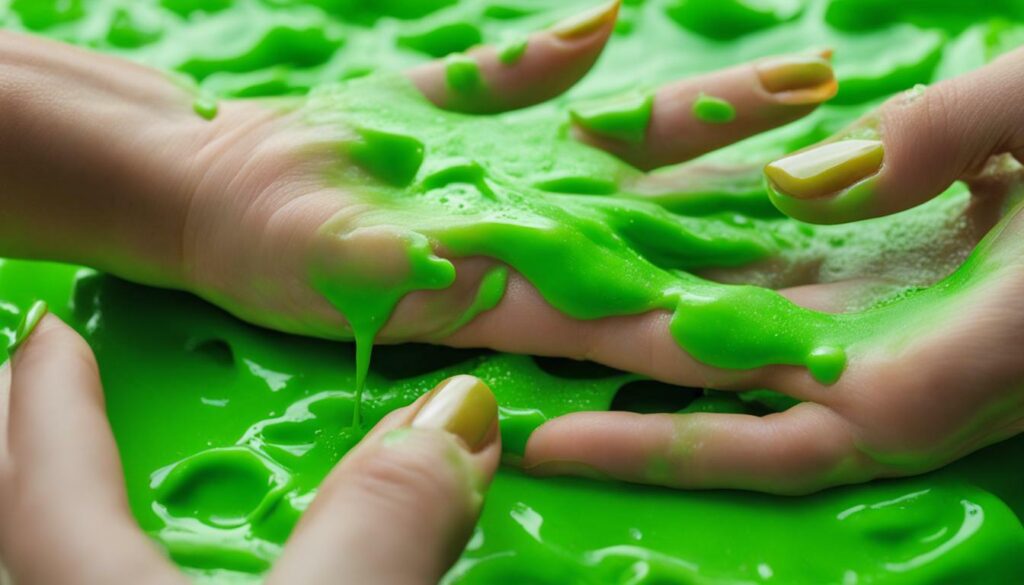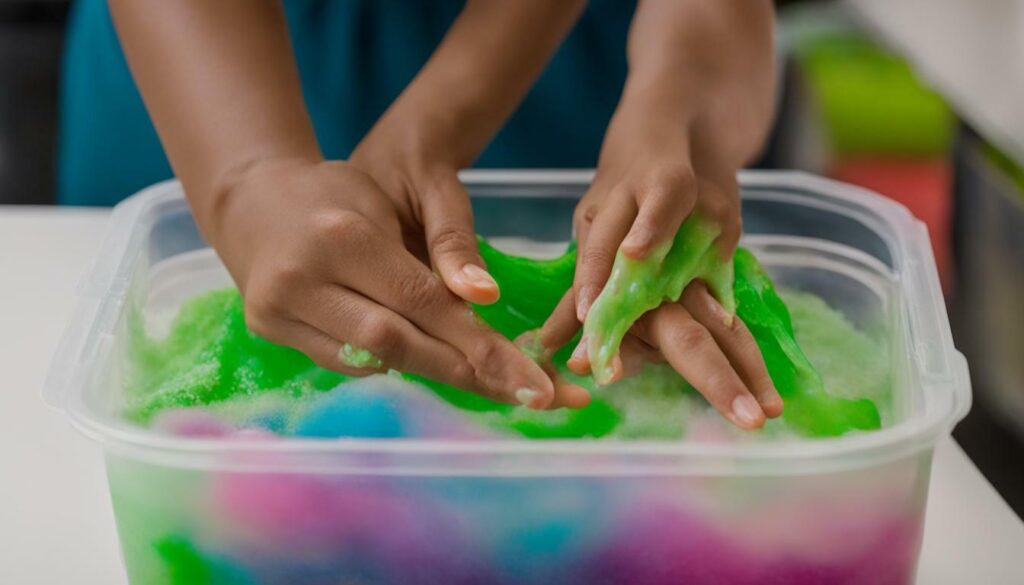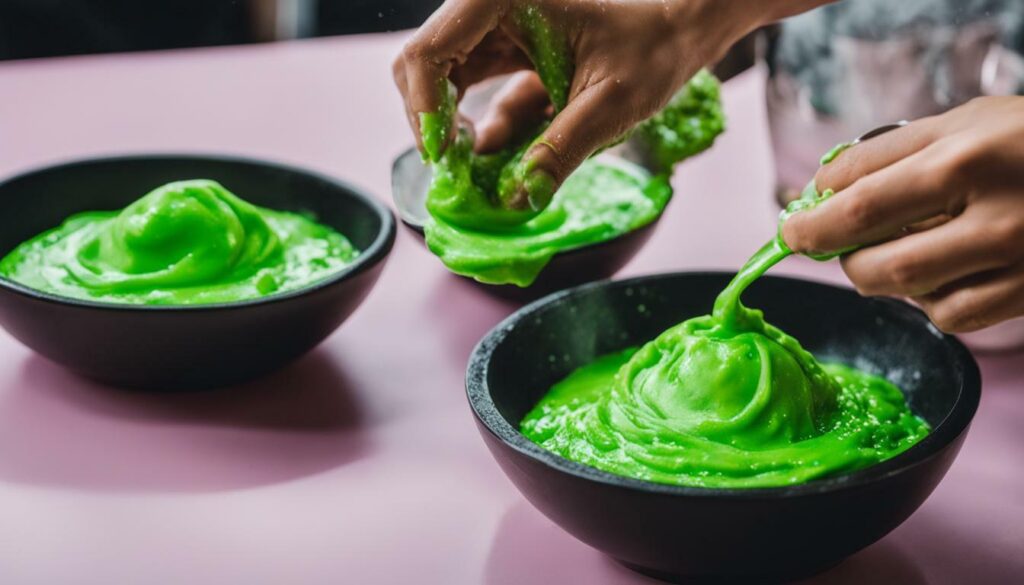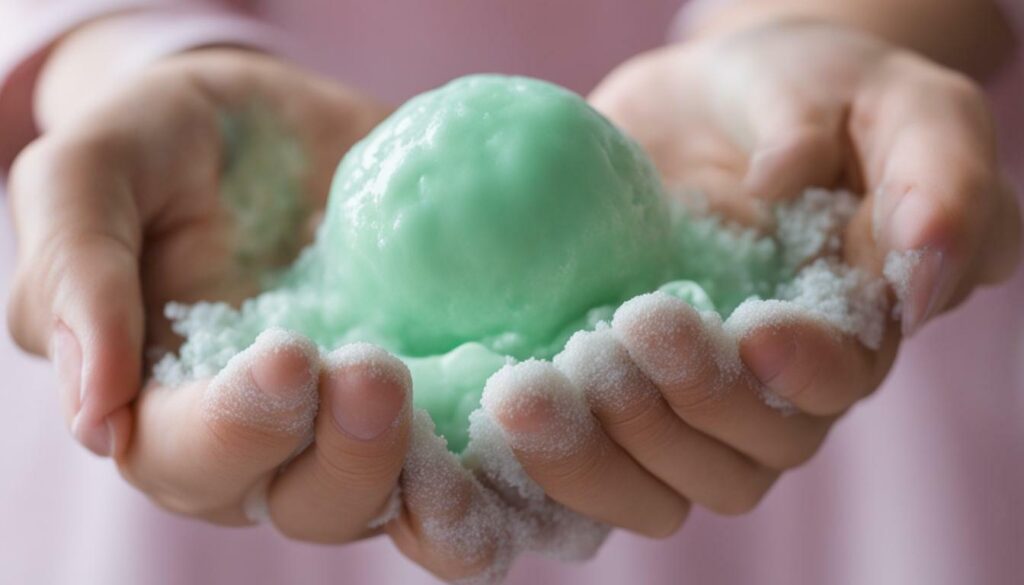Are you frustrated by the sticky mess whenever you play with slime? Let’s uncover why your slime is sticking to your fingers and how you can fix it.
Key Takeaways:
- If your slime is sticking to your fingers, try adding ½ teaspoon of baking soda or 1 teaspoon of contact solution to fix it.
- Adding a teaspoon of baby oil or kneading the slime more with your hands can also help reduce stickiness.
- Follow specific slime recipes and instructions, such as shaving cream slime or detergent and baking soda slime, to make them less sticky.
- Allowing the slime to breathe or sit out for a while can improve its texture and reduce stickiness.
- Read the recipe carefully and use the right ingredients to avoid sticky slime.
What Causes Slime to Stick to Your Fingers?
Slime can stick to your fingers due to a combination of factors, such as the ingredients used, the consistency of the slime, and the way you handle it. Understanding these factors will help you troubleshoot and prevent stickiness, ensuring a more enjoyable slime experience.
When making slime, the ingredients play a crucial role. Some recipes may call for more adhesive substances, such as glue or borax, which can result in stickier slime. Additionally, the type of glue or activator used can also impact the stickiness. It’s important to read the recipe carefully and follow the instructions regarding the specific ingredients required.
The consistency of the slime is another factor that can contribute to stickiness. Slime that is too wet or too dry may have a higher tendency to stick to your fingers. Achieving the right balance of ingredients and properly measuring them can help you achieve the desired consistency and reduce stickiness.
Finally, the way you handle the slime can also affect its stickiness. Over-kneading the slime or not kneading it enough can result in stickier texture. It’s important to knead the slime thoroughly but gently, allowing the ingredients to mix together properly without creating excess stickiness.


What Can You Do to Prevent Slime from Sticking to Your Fingers?
- Add ½ teaspoon of baking soda to the slime to reduce stickiness.
- Mix in 1 teaspoon of contact solution to help achieve a less sticky consistency.
- Add 1 teaspoon of baby oil to the slime to make it less likely to stick to your fingers.
- Knead the slime more with your hands to promote better mixing and reduce stickiness.
For specific slime recipes, such as shaving cream slime or detergent and baking soda slime, there are instructions and tips on how to make them less sticky. By following these techniques and adjusting the recipe to your desired consistency, you can create slime that is fun to play with, without the frustration of it sticking to your fingers.
Lastly, allowing the slime to breathe or sit out for a while can also help reduce stickiness. Giving the slime some time to rest can improve its texture and make it less likely to stick to your fingers.
Ways to Fix Sticky Slime
Don’t worry! There are several ways to fix sticky slime and enjoy a smooth and enjoyable sensory experience. If your slime is sticking to your fingers, there are a few simple solutions you can try. One option is to add ½ teaspoon of baking soda to the slime. Baking soda helps to neutralize the stickiness and create a firmer texture. Another option is to mix in 1 teaspoon of contact solution, which contains ingredients that help reduce stickiness.
If your slime is still sticky, you can try adding 1 teaspoon of baby oil. Baby oil provides lubrication and can make the slime less likely to stick to your fingers. Additionally, kneading the slime more with your hands can help distribute the ingredients evenly and improve the consistency. Sometimes, sticky slime just needs a little extra love and attention to become smooth and stretchy.
For those who are looking for specific slime recipes, like shaving cream slime or detergent and baking soda slime, there are instructions available on how to make them less sticky. These recipes often require specific ratios and techniques to ensure the slime is not too sticky. Following the instructions carefully and using the right ingredients will help you achieve the desired results.
Another tip to reduce stickiness is to let the slime breathe or sit out for a while. Allowing the slime to rest can help it settle and improve its texture. So, if you find that your slime is too sticky, try letting it sit uncovered for a short period of time before playing with it again. This simple step can make a significant difference in the stickiness of the slime.


| Problem | Solution |
|---|---|
| Sticky slime | Add ½ teaspoon of baking soda |
| Sticky slime | Mix in 1 teaspoon of contact solution |
| Sticky slime | Add 1 teaspoon of baby oil |
| Sticky slime | Knead the slime more with your hands |
| Specific slime recipes | Follow the instructions carefully and use the right ingredients |
| Sticky slime | Allow the slime to breathe or sit out for a while |
By implementing these tips and techniques, you can easily troubleshoot and fix sticky slime. Remember to experiment with different solutions and find what works best for you. With a little patience and creativity, you can enjoy a mess-free and enjoyable slime experience!
Adjusting the Slime Recipe
By making slight modifications to your slime recipe, you can easily eliminate the stickiness and create a more enjoyable sensory play. If you find that your slime is sticking to your fingers, there are several things you can try to fix it.
One option is to add ½ teaspoon of baking soda to the slime. Baking soda helps to reduce stickiness by absorbing excess moisture. Simply sprinkle it onto the slime and knead it in until the desired consistency is achieved.
Another solution is to mix in 1 teaspoon of contact solution. The contact solution contains an ingredient called borate, which helps to activate the slime and make it less sticky. Add the contact solution gradually while kneading the slime until it reaches the desired texture.
If your slime is still sticky, you can try adding 1 teaspoon of baby oil. Baby oil acts as a lubricant and helps to reduce friction between the slime and your fingers. Knead the slime with your hands, incorporating the baby oil until the stickiness is resolved.


For specific slime recipes, such as shaving cream slime or detergent and baking soda slime, there are instructions available on how to make them less sticky. These recipes often require specific ratios of ingredients, and following them carefully can help prevent stickiness.
Additionally, letting the slime breathe or sit out for a while can also help reduce stickiness. This allows any excess moisture to evaporate, resulting in a less sticky texture. However, be cautious not to leave the slime out for too long, as it can dry out and become less stretchy.
Remember, it’s important to read the recipe carefully and use the right ingredients to avoid sticky slime. Making these small adjustments to your slime recipe will ensure a smoother and less sticky sensory play experience.
Kneading and Play Techniques
Learning the right kneading and play techniques can help you achieve a non-sticky slime texture and enjoy hours of fun without the mess. Follow these tips to troubleshoot your sticky slime and prevent it from sticking to your fingers.
Kneading Techniques
Kneading is an essential step in slime-making that can significantly reduce stickiness. When kneading your slime, start by spreading it out on a clean surface and folding it back onto itself. Repeat this motion, pushing down with the heel of your hand, for about 5-10 minutes. This process helps evenly distribute the ingredients and activate the slime’s texture.
Another technique is to apply a small amount of lotion or oil to your hands before kneading the slime. This creates a barrier between the slime and your fingers, making it less likely to stick. Experiment with different lotions or oils, such as baby oil or coconut oil, to find the one that works best for you.
Play Techniques
When playing with slime, try to avoid contact with rough or sticky surfaces that can cause the slime to pick up debris and become stickier. Instead, opt for a clean, smooth surface like a tabletop or plastic tray. This will help maintain the slime’s non-sticky texture and prevent it from accumulating dirt or lint.
Additionally, it’s important to wash your hands before playing with slime to remove any oils or residues that could transfer onto the slime and increase stickiness. Drying your hands thoroughly before handling slime can also prevent excess moisture from making the slime sticky.
Remember, each slime recipe may require different kneading and play techniques, so be sure to follow the instructions provided. By mastering these techniques, you’ll be able to create slime that is stretchy, smooth, and completely non-sticky.
| Kneading Techniques | Play Techniques |
|---|---|
| Spread slime on a clean surface and fold it back onto itself, repeating the motion for 5-10 minutes. | Avoid contact with rough or sticky surfaces to prevent slime from picking up debris. |
| Apply lotion or oil to your hands before kneading to create a barrier between the slime and your fingers. | Wash your hands before playing with slime to remove oils or residues that could make it sticky. |
| Dry your hands thoroughly to prevent excess moisture from affecting the slime’s texture. |
By following these tips and techniques, you can overcome sticky slime and enjoy a smooth and stretchy texture every time you play.


Specific Slime Recipes and Tips
Different slime recipes require specific adjustments to minimize stickiness. Let’s dive into some popular slime recipes and learn how to make them less sticky. Whether you’re a beginner or an experienced slime enthusiast, these tips will help you achieve the perfect consistency.
Shaving Cream Slime
If your shaving cream slime is too sticky, there are a few modifications you can make. Start by adding a small amount of shaving cream to your slime and continue to mix it in until the stickiness reduces. You can also add a tiny bit of lotion to moisturize the slime and make it less likely to stick to your fingers. Remember to start with a basic slime recipe and gradually adjust the amounts of shaving cream and lotion until you achieve the desired texture.
Detergent and Baking Soda Slime
For detergent and baking soda slime, the key to reducing stickiness lies in the ratio of ingredients. If your slime is too sticky, try adding a small amount of baking soda to the mixture and knead it in thoroughly. This will help absorb any excess moisture and make the slime less sticky. You can also add a little extra laundry detergent to the mixture if needed, but be cautious not to add too much, as it may cause the slime to become too runny.
Letting Your Slime Breathe
Allowing your slime to rest and “breathe” can also help reduce stickiness. After making your slime, leave it uncovered in a dry and dust-free area for a couple of hours. This will allow the slime to dry out slightly and improve its texture. Remember to check on your slime regularly, as leaving it out for too long may cause it to become too dry and lose its stretchiness. If needed, you can add a few drops of water to bring it back to the desired consistency.
| Recipe | Modification |
|---|---|
| Shaving Cream Slime | Add shaving cream and lotion |
| Detergent and Baking Soda Slime | Add baking soda and adjust detergent |
| All Slime Recipes | Let slime breathe for a few hours |
Remember, when working with slime, it’s important to read the recipe carefully and use the right ingredients. Don’t be afraid to experiment and make adjustments to achieve the perfect balance of stretchiness and non-stickiness. With these tips and tricks, you’ll be able to enjoy a fun and mess-free slime experience!


Allowing Slime to Breathe
Giving your slime some time to breathe can work wonders in reducing stickiness. Discover the benefits of allowing your slime to rest and achieve the perfect texture for your playtime.
If your slime is sticking to your fingers, there are several things you can do to fix it. One option is to add ½ teaspoon of baking soda to the slime or mix in 1 teaspoon of contact solution. Another option is to add 1 teaspoon of baby oil or knead the slime more with your hands.
For specific slime recipes, like shaving cream slime or detergent and baking soda slime, there are instructions on how to make them less sticky. It’s important to read the recipe carefully and use the right ingredients to avoid sticky slime.
Additionally, letting the slime breathe or sit out for a while can also help reduce stickiness. Allowing the air to flow through the slime allows it to dry slightly, which can change its texture and make it less sticky. So, next time you make slime, give it some time to rest and enjoy a less sticky and more enjoyable playtime experience!
